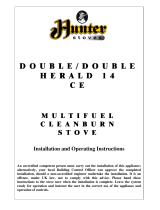
17
this provided the volume of coal products is less than that of other fuels. With
solid fuels, there is less need to burn the stove hard after refuelling. The rate of
refuelling will also be less often than with wood.
Avoid using the stove to incinerate other materials including household
waste. Avoid using ‘green’ unseasoned wood, treated wood such as tel-
egraph poles, or plywood / chipboard containing glues and resins which
pollute the environment and cause the fire to burn too quickly.
Such materials can produce excessive tar or creosote which can be
damaging and in extreme cases cause a fire inside the chimney.
The dryness of wood can be assessed by looking at the end of the log. Radial
cracks, deep enough to be considered as splits should be present in dry,
seasoned logs.
The maximum length of fuel suitable for this stove is approx. 30 cm so as to lay
flat over the embers, and logs of greater than 10 cm diameter should be split.
Confirm with your fuel provider as to which type will suit best. Larger fuels will
allow a greater draught in the firebox which will speed up combustion.
Household coal produces more ash & chimney deposits than smokeless fuels.
For further information on type and availability of fuel, the Solid Fuel
Association (http:/www.solidfuel.co.uk) serves as an advice centre to
domestic consumers including all aspects of fuel types.
The UK Smoke Control Areas website (http:/www.uksmokecontrolareas.co.uk)
defines the location of smoke controlled areas throughout England, Scotland,
Wales and Northern Ireland and lists all fuels which are authorised for use in
Smoke Control Areas. However, you should check with your local council to
confirm that you can use a stove in a smoke controlled area.
INITIAL SEASONING
Following installation, and before regular use, the stove must be seasoned to
prevent cracking of the metal casting. This procedure should also be
followed if the stove has not been used for prolonged periods (during the
summer months for example), and is carried out as follows:
1. Light a small fire in the middle of the stove, well away from the sides.
2. Allow the stove to warm up slowly and evenly with the air controls almost
closed, avoiding intense flames.
3. Keep the fire burning for three hours or so, gradually increasing the size of
the fire using larger logs which will burn naturally but slowly, keeping the
stove on a low setting.
4. After a couple of days burning at this level, increase the brightness &
intensity of the fire gradually over the next 10 days.
Full strength fires should not be used until completion of approx. 20 days of
mild use. Only from this time will the stove have been properly seasoned.





















